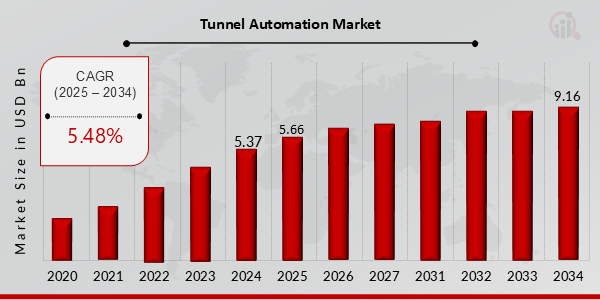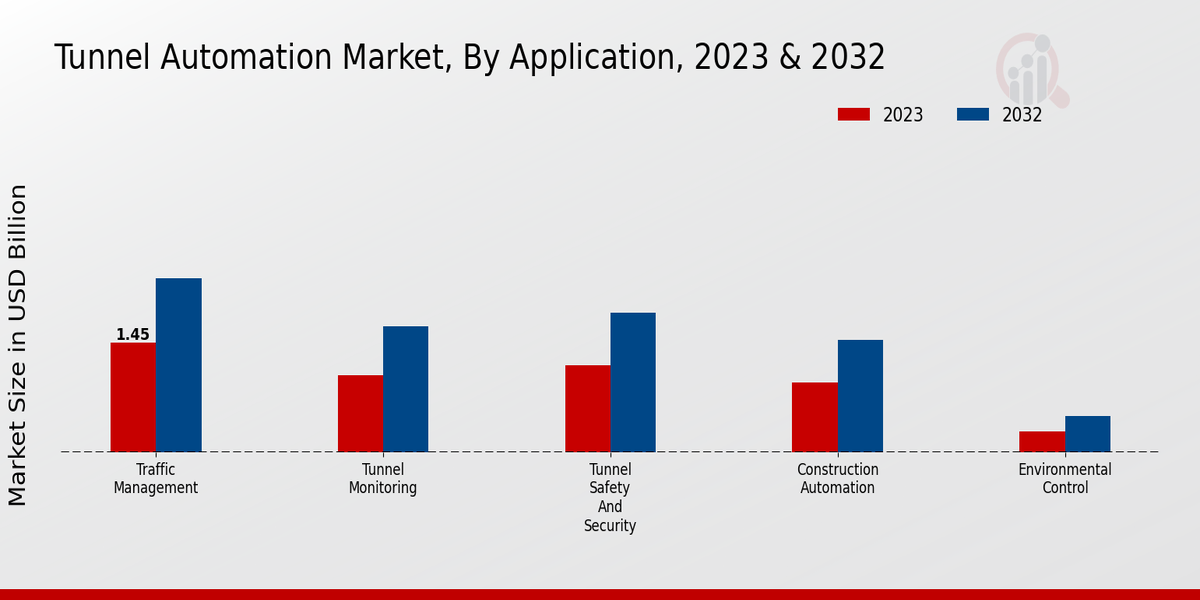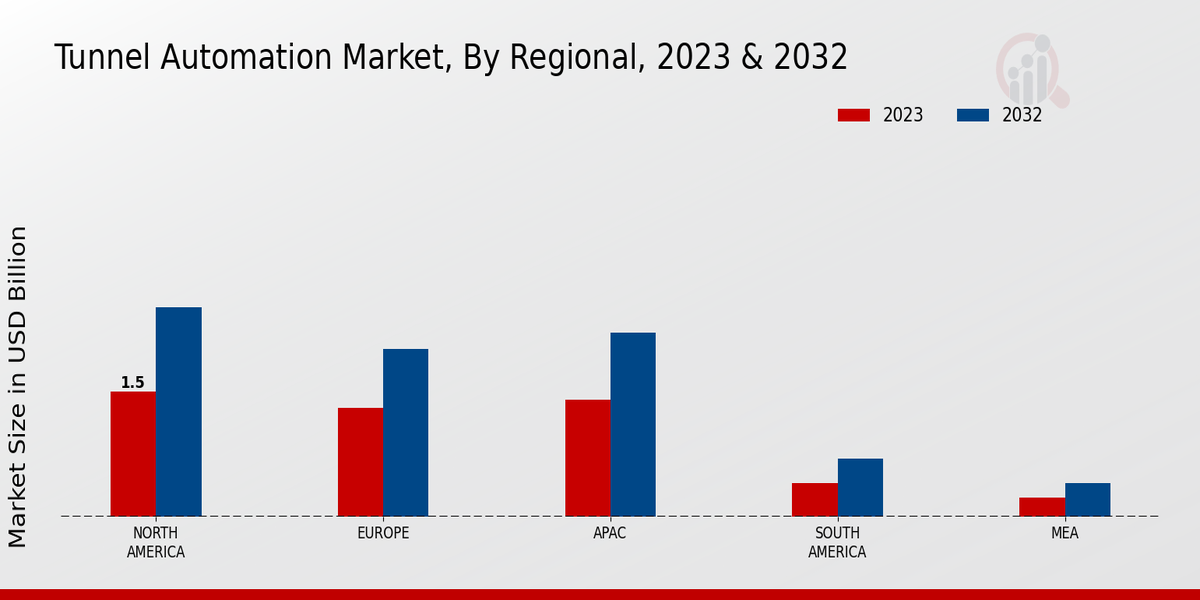Global Tunnel Automation Market Overview
Tunnel Automation Market Size was estimated at 5.37 (USD Billion) in 2024. The Tunnel Automation Market Industry is expected to grow from 5.66 (USD Billion) in 2025 to 9.16 (USD Billion) till 2034, exhibiting a compound annual growth rate (CAGR) of 5.48% during the forecast period (2025 - 2034).
Key Tunnel Automation Market Trends Highlighted
The Tunnel Automation Market is on fire growth and is fueled by factors such as urbanization together with the strong requirements for efficient modes of transport. Smart cities enhancing the sophistication of the populations are emerging. There is a wave of investment both from government and private sectors in infrastructure development to cater for urban sprawl and enhance connectivity. The publicity of the need to upgrade transport networks open up possibilities for the use of machines to perform tunneling activities. On the other hand, there is pressure from environmentalists which demand for construction to be done in a sustainable manner. Automation comes out as the technology of choice as it is precise and consumes fewer resources.
Herein, there is rich promise in the market for new technologies that will increase the efficiency and safety of the tunneling operations. Organizations that develop automated solutions stand a greater chance of increasing their market share as clients are focused on reducing labor inputs and delivery time. The use of IoT and AI in the tunneling processes gives organizations a chance to create smart, responsive systems that automatically adapt to ever changing conditions. Recently, the direction of the Tunnel Automation Market has focused on more enhanced customization and versatility of tunneling machines.
The center of attention is on the creation of machines that are capable of working in any geological environment with minimal human involvement. In addition, the growing cooperation between technical suppliers and engineers indicates, that the industry is moving towards a unified approach to construction where the automation combines with traditional tunneling techniques. This change is likely to change the standard operating procedures for the projects and introduce newer benchmarks in cost effectiveness and safety in tunnel building machines manufactured in the future. This indicates that there will be higher chances for the adoption of the fully automated processes in new projects in order to keep up with the pace of the technological evolution.

Source: Primary Research, Secondary Research, MRFR Database and Analyst Review
Tunnel Automation Market Drivers
Technological Advancements in Tunnel Automation
The Tunnel Automation Market Industry is experiencing significant growth due to continuous technological advancements that enhance the operational efficiency and safety of tunneling processes. Innovations such as the integration of Artificial Intelligence (AI), Internet of Things (IoT), and advanced robotics are transforming traditional tunneling operations. These advancements not only streamline project timelines but also improve precision in tunnel construction and maintenance.The use of real-time data analytics allows for better monitoring and predictive maintenance, which in turn reduces downtime and cost overruns. Automated systems can also improve worker safety by minimizing human involvement in hazardous activities.
Moreover, the implementation of tunnel automation technologies can ensure compliance with stringent safety regulations, further driving the market. As cities continue to expand and the demand for sustainable infrastructure grows, organizations are increasingly investing in automated solutions to cope with the challenges posed by urbanization.The need for enhanced productivity, safety, and cost-effectiveness is compelling stakeholders to adopt these technologies, which is expected to propel the Tunnel Automation Market Industry to new heights. Ultimately, as the industry continues to innovate and evolve, the synergy between technology and construction practices is poised to reshape the future landscape of tunneling projects, offering a competitive edge in the global market.
Growing Demand for Infrastructure Development
The increasing demand for infrastructure development, particularly in urban areas, is a key driver of the Tunnel Automation Market Industry. As populations grow and urbanization accelerates, the need for efficient transportation systems, including subways, highways, and utility tunnels, becomes crucial. Automated tunneling solutions facilitate the rapid construction of such infrastructure with higher precision and less disruption to the surrounding environment.This trend is fueling investments in tunnel automation technologies, as governments and private sector stakeholders look to optimize their projects and improve the overall quality of life in urban settings.
Focus on Environmental Sustainability
The Tunnel Automation Market Industry is increasingly influenced by the growing focus on environmental sustainability. As organizations strive to reduce their carbon footprints and improve energy efficiency, automated tunneling solutions represent a more sustainable alternative to conventional methods. These technologies often utilize less energy and generate fewer emissions, aligning with global efforts towards greener construction practices.Moreover, as environmental regulations become more stringent, automated systems can facilitate compliance while minimizing ecological disruption during tunneling operations. This shift towards sustainability not only helps in achieving regulatory compliance but also enhances the market attractiveness of tunnel automation solutions.
Tunnel Automation Market Segment Insights
Tunnel Automation Market Application Insights
The Tunnel Automation Market is expected to grow significantly, with a focus on various applications that enhance operational efficiency and safety in tunnel systems. Among these applications, Traffic Management holds a majority share, valued at 1.45 USD Billion in 2023 and projected to reach 2.31 USD Billion by 2032. This segment plays a critical role in the optimization of vehicular flow and ensures minimal congestion in tunnel operations, reflecting its importance in urban infrastructure development. Tunnel Monitoring, valued at 1.02 USD Billion in 2023 and expected to grow to 1.67 USD Billion by 2032, is essential for ensuring structural integrity and safety, relying on real-time data to detect anomalies and prevent accidents, thus making it a significant contributor to the market.The Tunnel Safety and Security application reflects a growing concern for maintaining the safety of both infrastructure and individuals, starting with a valuation of 1.15 USD Billion in 2023 and anticipated to rise to 1.85 USD Billion by 2032.
This segment dominates due to increasing investments in safety protocols and technologies to prevent incidents within tunnel environments. Construction Automation, valued at 0.93 USD Billion in 2023, is projected to see substantial growth, reaching 1.49 USD Billion by 2032, as it focuses on enhancing efficiency and reducing labor costs during the construction phase of tunnels. This sector is crucial, given the increasing demand for rapid construction without compromising quality. Lastly, the Environmental Control application, starting at 0.28 USD Billion in 2023 and set to reach 0.48 USD Billion by 2032, is increasingly significant as environmental regulations become stricter. This segment manages air quality and emissions within tunnels, showcasing the evolving focus on sustainability in infrastructure projects.
In summary, the Tunnel Automation Market segmentation reveals that applications like Traffic Management and Tunnel Safety and Security are dominant, driving substantial growth. The overall market growth reflects the increasing emphasis on automation technologies in ensuring safety, efficiency, and compliance with regulatory requirements, signaling a transformative trend in tunnel operations across the globe. With continued advancements and investments in these applications, the market is poised for steady expansion, driven by the need for improved infrastructure and technological integration.

Source: Primary Research, Secondary Research, MRFR Database and Analyst Review
Tunnel Automation Market Technology Insights
The Tunnel Automation Market focused on the Technology segment is expected to see significant growth, with the overall market valued at 4.83 USD Billion in 2023 and projected to reach 7.8 USD Billion by 2032. This sector encompasses vital systems designed to enhance operational efficiency and safety in tunnel environments. Automated Ventilation Systems play a crucial role in regulating air quality, ensuring a safe atmosphere for users. Fire Detection Systems are essential for early hazard detection, significantly minimizing risks associated with fire incidents.Meanwhile, Lighting Control Systems enhance visibility and energy efficiency within tunnels, which improves safety and reduces operational costs. Surveillance Systems are increasingly significant for security and monitoring purposes, providing real-time insights into activities within the tunnel.
Control Centers serve as the nerve center for managing these various systems, integrating data and facilitating swift responses during emergencies. The market growth in this segment is driven by rising urbanization, increased infrastructure development, and the demand for smart transportation solutions, all of which emphasize the importance of advanced technology in tunnel management.Overall, the diversification and enhancements in these technologies reflect a positive trajectory in the Tunnel Automation Market revenue.
Tunnel Automation Market End Use Insights
The Tunnel Automation Market is witnessing notable growth across various end-use segments, contributing significantly to the overall market revenue, which was valued at 4.83 billion USD in 2023. The Transportation sector plays a vital role, as advancements in automated solutions enhance safety and efficiency in tunneling projects, aligning with increasing urbanization and infrastructure development. In Mining, automation improves operational efficiency and worker safety while reducing operational costs, thus driving its prominence in the market.
Utilities also leverage tunnel automation to optimize underground resource management, ensuring effective service delivery. The Civil Engineering sector further emphasizes the necessity for automation in streamlining construction processes and mitigating project delays. Additionally, Railways represent a growing area within the Tunnel Automation Market, where automated systems help in the efficient management of rail infrastructure and safety, catering to the rising demand for sustainable transport solutions. The overall market statistics reflect a robust growth trajectory supported by technological advancements, driven by the need for safety, efficiency, and reduced operational costs across the different end-use segments.
Tunnel Automation Market System Type Insights
The Tunnel Automation Market is experiencing notable growth, expected to be valued at 4.83 billion USD in 2023, with the System Type segment contributing significantly to this expansion. This segment encompasses various critical components, including Hardware, Software, and Services, each playing a vital role in enhancing operational efficiency and safety within tunnel infrastructures. Hardware solutions typically focus on the physical equipment necessary for automation, while Software systems facilitate data analysis and operational control, and driving decision-making processes.Moreover, Services, including system integration and maintenance, support the ongoing functionality and reliability of tunnel automation systems. The increasing investment in infrastructure development and the rise in urbanization are driving these segments’ importance, thus leading to a majority holding in the overall market. Additionally, advancements in digital technologies and IoT are positioning Software as a key driver of innovation within the sector. As the market continues to evolve, integrating these elements remains essential for maximizing the effectiveness and safety of tunnel operations.Overall trends and market growth within this System Type segment highlight its pivotal role in shaping the Tunnel Automation Market.
Tunnel Automation Market Regional Insights
The Tunnel Automation Market is set to witness robust growth across various regions, with the overall market valued at 4.83 USD Billion in 2023. North America holds a significant position, valued at 1.5 USD Billion, which is expected to increase to 2.5 USD Billion by 2032, demonstrating its major role in market advancement. Following closely, Europe is valued at 1.3 USD Billion in 2023, projected to rise to 2.0 USD Billion, indicating its important contribution to the tunnel automation sector. The APAC region, valued at 1.4 USD Billion, is likely to grow to 2.2 USD Billion, highlighting its significant potential driven by rapid urbanization and infrastructure projects.South America and MEA, though smaller, are also important in the overall dynamics, with values of 0.4 USD Billion and 0.23 USD Billion in 2023, projected to reach 0.7 USD Billion and 0.4 USD Billion respectively. These regions are gradually adopting advanced technologies, presenting various opportunities while facing challenges such as investment and regulatory frameworks. The Tunnel Automation Market revenue, along with various regional insights and market trends, reflects a diverse and evolving industry landscape.

Source: Primary Research, Secondary Research, MRFR Database and Analyst Review
Tunnel Automation Market Key Players and Competitive Insights
The Tunnel Automation Market is characterized by a dynamic environment where several players strive to establish their foothold and innovate continually. As urbanization and infrastructure requirements grow, the need for efficient tunnel management systems is increasingly recognized. This has led to significant investments in automation technologies that aim to enhance the safety, efficiency, and cost-effectiveness of tunnel operations. Companies in this space compete on various fronts, including technology advancements, operational efficiency, customized solutions, and strategic partnerships. The competitive landscape is shaped by the necessity to fulfill regulatory demands and meet the evolving expectations of end-users.Hitachi has effectively positioned itself as a key player in the Tunnel Automation Market, drawing attention for its robust technological capabilities and commitment to innovation. The company's strengths in automation solutions are reflected in its sophisticated product offerings that streamline tunnel operations, enhance monitoring, and improve predictive maintenance.
Hitachi's extensive experience in implementing large-scale infrastructure projects gives it a competitive edge in understanding the complexities associated with tunnel automation. The firm is known for its strong focus on research and development, which enables it to consistently bring forward cutting-edge solutions that meet the specific needs of its clients. Additionally, its ability to leverage data analytics and IoT technologies further strengthens its market presence.Honeywell's impact on the Tunnel Automation Market is notable, as the company capitalizes on its comprehensive suite of automation solutions tailored for tunnel operations. Honeywell's strengths are evident in its innovative product range, designed to enhance the safety, efficiency, and reliability of tunnel systems. The company boasts a strong technological backbone that facilitates seamless integration with existing infrastructure, making it an attractive choice for operators looking to upgrade their systems. Honeywell's focus on sustainability and energy efficiency also resonates with industry trends and governmental policies aimed at reducing the environmental footprint of construction projects. Its commitment to providing end-to-end solutions, including monitoring and control systems, positions Honeywell as a formidable contender in the competitive landscape of tunnel automation.
Key Companies in the Tunnel Automation Market Include
- Hitachi
- Honeywell
- SICK AG
- FANUC
- Mitsubishi Electric
- Thyssenkrupp
- General Electric
- Emerson Electric
- ABB
- Schneider Electric
- Toshiba
- Siemens
- Rockwell Automation
- KUKA
- Baumer Group
Tunnel Automation Market Industry Developments
Recent developments in the Tunnel Automation Market have been characterized by significant technological advancements and strategic initiatives among key players. Companies such as Hitachi and Honeywell are increasing their focus on digital technologies to enhance operational efficiency and safety in tunnel construction and maintenance. In current affairs, the market is witnessing a growing demand for automation due to the expanding infrastructure projects worldwide, which are fostering investments and collaborations among industry leaders, including SICK AG and Siemens. Mergers and acquisitions are becoming a common trend, with notable activity from companies such as Mitsubishi Electric, which is enhancing its product offerings by partnering smaller tech firms. Moreover, Thyssenkrupp and ABB are focusing on smart technologies and AI to streamline tunnel operations, thus increasing their competitive edge in the market. Additionally, the market is experiencing valuation growth, with companies adapting to the rising needs for sustainability and efficient resource management in tunnel automation, reinforcing their market positions while responding effectively to environmental concerns. The intersection of innovation and infrastructure development is shaping the future landscape of tunnel automation significantly.
Tunnel Automation Market Segmentation Insights
-
Tunnel Automation Market Application Outlook
- Traffic Management
- Tunnel Monitoring
- Tunnel Safety and Security
- Construction Automation
- Environmental Control
-
Tunnel Automation Market Technology Outlook
- Automated Ventilation Systems
- Fire Detection Systems
- Lighting Control Systems
- Surveillance Systems
- Control Centers
-
Tunnel Automation Market End Use Outlook
- Transportation
- Mining
- Utilities
- Civil Engineering
- Railways
-
Tunnel Automation Market System Type Outlook
- Hardware
- Software
- Services
-
Tunnel Automation Market Regional Outlook
- North America
- Europe
- South America
- Asia Pacific
- Middle East and Africa
|
Report Attribute/Metric
|
Details
|
|
Market Size 2024
|
USD 5.37 Billion
|
|
Market Size 2025
|
USD 5.66 Billion
|
|
Market Size 2034
|
USD 9.16 Billion
|
|
Compound Annual Growth Rate (CAGR)
|
5.48% (2025-2034)
|
|
Base Year
|
2024
|
|
Market Forecast Period
|
2025-2034
|
|
Historical Data
|
2020-2023
|
| Market Forecast Units |
USD Billion |
| Key Companies Profiled |
Hitachi, Honeywell, SICK AG, FANUC, Mitsubishi Electric, Thyssenkrupp, General Electric, Emerson Electric, ABB, Schneider Electric, Toshiba, Siemens, Rockwell Automation, KUKA, Baumer Group |
| Segments Covered |
Application, Technology, End Use, System Type, Regional |
| Key Market Opportunities |
Smart city infrastructure integration, Increased demand for safety solutions, Advancements in AI and IoT, Sustainability initiatives in construction, Government investment in infrastructure projects |
| Key Market Dynamics |
Growing urbanization and infrastructure demand, Increasing safety regulations and standards, Advancements in automation technologies, Rising labor costs and skill shortages, Environmental sustainability and energy efficiency trends |
| Countries Covered |
North America, Europe, APAC, South America, MEA |
Frequently Asked Questions (FAQ) :
In 2034, the Tunnel Automation Market is expected to be valued at 9.16 USD Billion.
The expected CAGR for the Tunnel Automation Market from 2025 to 2034 is 5.48%.
North America is expected to hold the largest market share in the Tunnel Automation Market in 2032, valued at 2.5 USD Billion.
The market value of the Tunnel Monitoring application is expected to reach 1.67 USD Billion in 2032.
Major players in the Tunnel Automation Market include companies like Hitachi, Honeywell, and Siemens.
The projected market size for the Traffic Management application is expected to reach 2.31 USD Billion in 2032.
The Environmental Control application is expected to achieve a market value of 0.48 USD Billion by 2032.
By 2032, the market size for the Construction Automation application is projected to reach 1.49 USD Billion.
The expected market value of the Tunnel Automation Market in 2023 is 4.83 USD Billion.
Growth opportunities in the Tunnel Automation Market include advancements in technology and increasing infrastructure development.

















